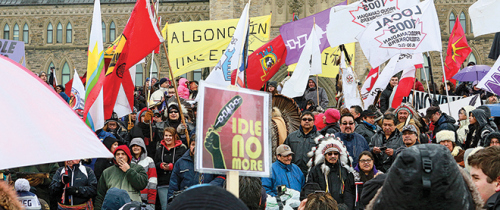When Native protestors were talking last year, Canadian intelligence agency was paying close attention

Justin Ling, MACLEANS’s
Sitting in her teepee on Ottawa’s Victoria Island in December 2012, Attawapiskat Chief Theresa Spence was officially starting her hunger strike, breathing fire into the Idle No More movement and setting off a chain reaction that would eventually force Ottawa into talks on the nature of Canada’s relationship with First Nations. Meanwhile, five blocks away as the crow flies, the federal government’s security and emergency nervous system was ramping up its efforts to keep tabs on the movement. Just how extensive, and often ham-handed, the surveillance was is only now coming to light with the release of thousands of new documents.
The little-known Government Operations Centre ran that surveillance program from Ottawa’s Laurier Avenue West. Half of the program included public “situational awareness reports” on the protests. But the government also prepared secret “restricted distribution addendums” that were forwarded to CSIS, the RCMP and the Defence Ministry’s Canadian Joint Operations Command. They included exclusive information on proposed economic disruptions, such as bridge and rail blockades. One classified report released Jan. 2 noted the joint American-Canadian-operated Blue Water Bridge “would not tolerate any bridge closures/slowdowns.”
CSIS’s involvement is revealed in other ways. On Jan. 17, representatives from Aboriginal Affairs, the RCMP and the spy agency’s Integrated Terrorism Assessment Centre (ITAC) met to discuss the “potential for escalation” for the movement. The centre, created in 2004 and housed within CSIS, does threat assessments for domestic and foreign terror attacks. According to a CSIS spokesperson, ITAC was only involved due to a threat against Idle No More itself. “ITAC does not monitor Idle No More, as they do not meet the definition of terrorism from the Criminal Code of Canada,” the spokesperson says. Meeting notes suggest officials feared that outside groups were attempting to infiltrate Idle No More. “Non-Aboriginal movements [are] starting to move in,” the notes stated, including “anarchists” and the “black bloc.” CSIS would not comment on the specifics of their concerns.
Charlie Angus, the NDP MP for Timmins-James Bay—which includes Spence’s Attawapiskat reserve—is not surprised at the resources Ottawa poured into its response to the protest. “The message was always that these manifestations of outpouring of First Nations were something that needed to be managed, something to contain and possibly a threat,” he says. He accepts there may have been more radical elements in the movement. “Of course there are other left-wing groups that might join, but there was never any sense, as far as I can see, of menace or threat.”
Emails to and from Aboriginal Affairs staffers cite social media and “open-source reporting” as main sources of information—something Pamela Palmater, a political science professor at Ryerson University and a First Nations activist heavily involved in Idle No More, saw first-hand. She’d suspected government staffers were watching her social-media profiles. “They’re easy to pick out on Facebook,” she says. They’d add her as a friend and offer counterpoints to her posts that bore a striking resemblance to departmental talking points. “Who is it they’re watching? They’re watching people like me, who have no criminal record, doing nothing violent.”
Palmater says that at one talk she gave about Idle No More, she jokingly said that if any government staffers were in the audience, they were obliged to come forward. By the end, three staffers from Aboriginal Affairs and Justice had lined up to out themselves.
At one point, a group of developers created an Idle No More app that allowed activists to share information and plan protests, flash mobs and round dances. Deputy Minister of Aboriginal Affairs Michael Wernick contacted his communications director to see if the office could surreptitiously piggyback on the app to get its own message across. “Is it in any way feasible to get our backgrounders into the flow of this app without the appearance of [government] ringers calling into an open-line show?” he asks in one document.
Whether the government actually followed through is not clear. However Steven Bryant, who co-created the app, says, “We definitely did wonder when we had some of our signups.” He says a slew of the addresses came from downtown Ottawa, and he suspected that government staff were using his app.
Media lines from the department stress that the federal government does not operate as Big Brother to First Nations: “[Aboriginal Affairs] does not perform any type of ‘surveillance’ of any individuals, groups, or communities,” says one communiqué. Palmater scoffs at that, citing the case of Cindy Blackstock, a First Nations child rights advocate who was under surveillance by the government’s own admission. With Idle No More, it’s snooping, not spying; still, “I don’t think they should be treating us like domestic terrorists,” says Palmater.
